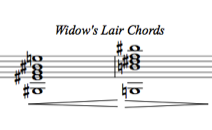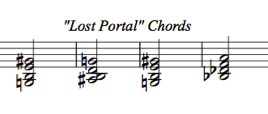ORC: Vengeance
Nominated for Game Audio Network Guild Awards 2013 - Best Handheld Audio
Notes on Themes and Harmony


Orc: Vengeance was an opportunity to create a thematic score -- featuring over 30 minutes of original music -- for an incredible, fantasy hack-and-slash RPG game (Best of App Store 2012). The beautiful, dark art style and the gritty subject matter allowed me to dig into one of my favorite scales: the octatonic (see Messiaen's second mode of limited transposition for detailed information).
The clearest examples of the octatonic scale are the main and the boss themes. The thematic figures developed in the two tracks are the ideas that the rest of the soundtrack grew out of. You'll hear these fragments throughout, sometimes in the foreground, sometimes as an ostinato accompaniment figure, developed by augmentation, variation etc.

The menu thematic figure (above) is one of the primary ideas, as described above. Notice the turn of notes G#, G natural, A# and B, you'll find that little four-note motif in the boss theme and as an accompaniment or melodic figure in various tracks throughout.

Widow's Lair track is a great example of the detail that went into the 'ambient' tracks of the game. One of the best aspects of the octatonic harmonic scheme, in my personal opinion, is that it allows for great freedom in the independent ostinato patterns in different registers and instruments.
You can hear the rhythmic pedal figure in the lower register and the wandering textural figure in the violins, only connected by their shared harmonic scale. The above chord progression appears in the second half of the track. The slow, dramatic build to the chord change was an important musical concept for the ambient tracks overall.
You can hear the rhythmic pedal figure in the lower register and the wandering textural figure in the violins, only connected by their shared harmonic scale. The above chord progression appears in the second half of the track. The slow, dramatic build to the chord change was an important musical concept for the ambient tracks overall.

The boss theme is given extra weight by those booming and abrasive trombones. It features the interesting dissonances that are naturally part of the octatonic scale. The instrumental weight appropriately suggests a boss battle.

The Lost Portal ambient track brings to the foreground some of the ideas used in the slower paced music throughout the soundtrack. The chords feature clashing minor and major thirds and the slow, crescendo and diminuendo (after the chord change) highlight the tension and increase 'weight' of the chords. The above progression begins at the start of the piece and is driven by the high pitched chromatic violins.

The Brothers theme was another one of the melodic ideas developed early on in the process. The soundtrack, overall, is clearly dark, gritty but the element of heroism in our protagonist's task to rescue his brothers needed a thematic response.
The theme only appears twice throughout the game, once during the rescue level and once in the final level. Harmonically it's very different from the rest of the score but the instrumental aspects keep it closely tied to the soundtrack. Also, listen for a fragment of the main theme developed by augmentation and harmonized with 'heroic' chords.
The theme only appears twice throughout the game, once during the rescue level and once in the final level. Harmonically it's very different from the rest of the score but the instrumental aspects keep it closely tied to the soundtrack. Also, listen for a fragment of the main theme developed by augmentation and harmonized with 'heroic' chords.

The above track is a glance at some of the other, more independent combat tracks of the soundtrack. It features a rhythmic idea descended from the main theme. This track also showcases some interesting meters. 9/8, 7/8 and 2/4 are all used -- with sudden changes from one to the other. Most of the battle pieces alternate between forward-driving uneven meters (5/8, 7/8) and the 2/4 march rhythm.
Hope you've enjoyed the quick insight into the music!
Hope you've enjoyed the quick insight into the music!